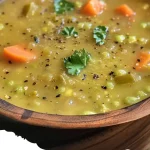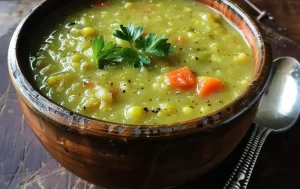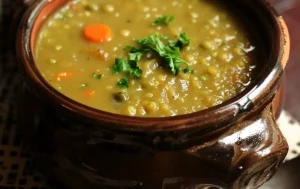Split Pea Soup is a hearty, comforting dish that has warmed the hearts and homes of many through the ages. This classic soup, made from dried split peas, is known for its thick consistency, vibrant color, and ability to incorporate various flavors from simple ingredients. Whether enjoyed as a warming lunch on a chilly day or as a fulfilling dinner, Split Pea Soup stands out for its nutritious profile and satisfying taste.
Print
Split Pea Soup
- Total Time: 18 minute
- Yield: Serves 6-8 1x
- Diet: Vegetarian
Description
Split Pea Soup is a hearty, comforting dish made from dried split peas, vegetables, and often ham or bacon for added flavor. It’s a thick, creamy soup known for its ease of preparation and nutritious benefits, making it a favorite during colder months or any time you crave a satisfying meal.
Ingredients
1 cup (160g) chopped yellow onions
2 cloves garlic, minced
1/8 cup (30ml) good olive oil
1/2 teaspoon dried oregano
1–1/2 teaspoons kosher salt
1 teaspoon freshly ground black pepper
2 cups (320g) medium-diced carrots (3 to 4 carrots)
1 cup (160g) medium-diced red boiling potatoes, unpeeled (3 small)
1 pound (450g) dried split green peas
8 cups (1.9 liters) chicken stock or water
Instructions
In a 4-quart stockpot on medium heat, sauté the onions and garlic with the olive oil, oregano, salt, and pepper until the onions are translucent, 10 to 15 minutes.
Add the carrots, potatoes, 1/2 pound (225g) of split peas, and chicken stock. Bring to a boil, then simmer uncovered for 40 minutes. Skim off the foam while cooking.
Add the remaining split peas and continue to simmer for another 40 minutes, or until all the peas are soft. Stir frequently to keep the solids from burning on the bottom.
Taste for salt and pepper. Serve hot.
Notes
- For a vegetarian version, use vegetable broth and omit the ham.
- Blending part of the soup can create a creamier texture, but it’s optional based on your preference.
- The soup thickens as it cools; add water or broth when reheating if necessary.
- Prep Time: 10 minutes
- Cook Time: 1.5 hours
- Category: Soup
- Method: Simmering
- Cuisine: International
Nutrition
- Calories: Approximately 200 per serving (without ham)
- Sugar: 5g
- Sodium: Depending on broth and added salt, varies
- Fat: 1g
- Carbohydrates: 35g
- Fiber: 15g
- Protein: 12g
FAQs About Split Pea Soup
Can I make Split Pea Soup in a slow cooker? Yes, you can easily make Split Pea Soup in a slow cooker. Simply add all ingredients to the slow cooker and cook on low for 8 hours or on high for 4 hours, until the peas are soft and the soup has reached your desired consistency.
Do I need to soak the split peas before cooking? Soaking split peas is not necessary for making Split Pea Soup, as they cook down well during the simmering process. However, if you choose to soak them, it can reduce cooking time slightly.
How can I thicken my Split Pea Soup? If your soup is thinner than you’d like, continue cooking it uncovered to allow some of the liquid to evaporate. You can also puree a portion of the soup and mix it back in to achieve a thicker consistency.
Is Split Pea Soup healthy? Split Pea Soup is quite nutritious, offering a good source of plant-based protein, fiber, vitamins, and minerals. To make it even healthier, you can limit the amount of salt and use lean meat options or make it vegetarian.
Can I freeze Split Pea Soup? Absolutely! Split Pea Soup freezes well. Cool the soup completely before transferring it to freezer-safe containers. Leave some space for expansion, and freeze for up to 3 months. Thaw overnight in the refrigerator and reheat gently on the stove.
Choosing Quality Ingredients
The key to a delicious Split Pea Soup lies in the quality of its ingredients. Begin with high-quality dried split peas, which form the base of the soup. Opt for fresh vegetables like carrots, celery, and onions to add depth and sweetness. For a richer flavor, include pieces of ham or bacon, though the soup can easily be made vegetarian by omitting these or substituting with smoked paprika for that smoky essence.
Preparing the Vegetables and Peas
Start by rinsing the split peas under cold water to remove any dirt or debris. Meanwhile, dice the carrots, celery, and onions into uniform pieces to ensure they cook evenly. If including meat, cut it into small cubes or strips. This preparation step is crucial for building the soup’s foundation, blending textures and flavors harmoniously.
Cooking the Soup
In a large pot, sauté the onions, carrots, and celery with a bit of oil until they begin to soften. Add the rinsed split peas, your choice of meat (if using), and enough water or stock to cover the ingredients. Season with salt, pepper, and any other desired herbs like thyme or bay leaves. Bring the mixture to a boil, then reduce the heat and let it simmer, stirring occasionally, until the peas are soft and the soup has thickened to your liking.
Blending for Smoothness
For those who prefer a smoother texture, part of the soup can be blended until smooth and then reintroduced to the pot. This step is optional but can add a creamy consistency that contrasts beautifully with the chunks of vegetables and meat. Adjust the seasoning after blending, as the flavors can change in intensity.
Serving Suggestions
Split Pea Soup is traditionally served hot, with a sprinkle of fresh parsley or croutons on top for added texture. A side of crusty bread makes an excellent accompaniment, perfect for dipping into the thick soup. For a lighter meal, a simple green salad on the side can balance the heartiness of the soup, creating a well-rounded dining experience.
Customizing Your Split Pea Soup
The beauty of Split Pea Soup lies in its versatility. Feel free to customize the recipe based on your dietary preferences or what you have on hand. Vegetarians can achieve the smoky flavor traditionally provided by ham by adding liquid smoke or smoked paprika. For a heartier version, consider incorporating diced potatoes or turnips. Creative additions like a splash of sherry or a dollop of sour cream before serving can elevate the flavor profile, making the soup even more memorable.
Storing and Reheating
Split Pea Soup stores remarkably well, making it an excellent option for meal prep or leftovers. Allow the soup to cool before transferring it to airtight containers. It can be refrigerated for up to 5 days or frozen for up to 3 months. When reheating, you may need to add a bit of water or broth to adjust the consistency, as the soup tends to thicken when chilled.
Nutritional Benefits
Not only is Split Pea Soup delicious, but it’s also packed with nutritional benefits. Split peas are a great source of plant-based protein and fiber, contributing to feelings of fullness and digestive health. The vegetables add essential vitamins and minerals, making this soup a wholesome choice for fueling your body.
Engaging the Family
Cooking Split Pea Soup can be a delightful family activity, from preparing the vegetables to enjoying the warm, comforting bowls together. Encouraging children to participate in the kitchen is a great way to teach them about nutrition and culinary skills. Personalizing the soup with their favorite ingredients can make the experience even more enjoyable for them.
Celebrating Tradition and Innovation
While Split Pea Soup has traditional roots, it also represents the potential for innovation in the kitchen. By experimenting with ingredients and cooking methods, you can put a modern twist on this timeless dish. Whether sticking to the classic recipe or introducing new flavors, Split Pea Soup remains a testament to the power of simple, nourishing food to bring people together.
Enhancing Flavor with Garnishes
Adding garnishes to Split Pea Soup just before serving can significantly enhance its flavor and visual appeal. A sprinkle of fresh herbs, such as parsley or thyme, introduces a burst of color and freshness. For a crunchy contrast, homemade croutons or a handful of crispy bacon bits can add texture and richness. A swirl of olive oil or a squeeze of lemon juice can brighten the soup, adding a layer of complexity to its savory depth.
Pairing with Beverages
Selecting the right beverage to accompany Split Pea Soup can round out the dining experience. A light-bodied white wine, such as Sauvignon Blanc, pairs well with the soup’s earthy flavors, while for non-alcoholic options, a sparkling water with a wedge of lemon complements the soup’s richness without overwhelming it. The key is to choose a drink that refreshes the palate between bites.
Incorporating International Flavors
While Split Pea Soup is deeply rooted in many cultures, incorporating international flavors can transform this classic dish into a global culinary adventure. Adding coconut milk and curry spices can give the soup a Thai-inspired twist, while a spoonful of harissa or cumin can lend a North African flair. These variations invite you to explore different palates and traditions through a familiar format.
Maximizing Leftover Soup
Leftover Split Pea Soup can serve as a versatile base for other dishes. Thickened soup can be used as a filling for savory pies or as a sauce for a protein-rich grain bowl. Getting creative with leftovers not only minimizes food waste but also allows you to enjoy the delicious flavors of Split Pea Soup in new and exciting ways.
Fostering Community Through Cooking
Sharing Split Pea Soup with neighbors, friends, or community members is a heartwarming way to foster connections and spread comfort. Hosting a soup swap or contributing a large batch to a community meal can showcase the soup’s humble origins and its ability to bring people together. In doing so, Split Pea Soup becomes more than just a meal; it becomes a means of sharing and caring within a community.
Exploring Soup as a Seasonal Delight
Embracing the changing seasons through your cooking can bring new life to Split Pea Soup. In the spring, incorporating fresh peas or tender asparagus tips can add a bright, fresh element. During the autumn and winter months, the addition of root vegetables or a hint of pumpkin can transform the soup into a more warming and comforting dish. This seasonal approach ensures that Split Pea Soup remains a versatile and appealing option throughout the year.
Utilizing High-Quality Cookware
The choice of cookware can significantly impact the cooking process and final outcome of Split Pea Soup. A heavy-bottomed pot or Dutch oven ensures even heat distribution, preventing the soup from sticking or burning at the bottom. Investing in quality cookware not only improves the cooking experience but also contributes to the soup’s overall texture and flavor, making each batch consistently delightful.
Hosting Soup Nights
Organizing soup nights is a wonderful way to bring friends and family together over a meal that’s both simple and satisfying. Encourage guests to bring their unique version of this recipe or another favorite soup to share. This communal gathering can become a cherished tradition, offering an opportunity to enjoy a variety of soups and fostering a sense of community and warmth.
Teaching Soup-Making Skills
Passing on the skills and knowledge of making this recipe to others is a valuable way to keep culinary traditions alive. Whether it’s teaching children the basics of soup preparation or hosting a cooking class focused on soups, these teaching moments can inspire a new generation of cooks to appreciate the joys of homemade soup. Sharing recipes, techniques, and personal tips enriches the learning experience, making it rewarding for both teacher and student.
Celebrating the Simplicity of Soup
In a world of complex and time-consuming recipes, the simplicity of this recipe stands out as a testament to the beauty of minimalist cooking. This dish celebrates the fundamental joy of transforming basic ingredients into a meal that’s both nutritious and comforting. By embracing the simplicity of soup, cooks of all levels can appreciate the satisfaction that comes from creating something truly nourishing from the humblest of components.
Conclusion
This recipe is a classic dish that exemplifies the comfort and nourishment that can be found in a bowl of homemade soup. With its rich flavors, versatile nature, and the warmth it brings to any meal, it’s a beloved recipe that transcends seasons and trends. Whether you’re enjoying a quiet dinner at home, sharing a meal with loved ones, or teaching the next generation the joys of cooking, Split Pea Soup is more than just food—it’s a symbol of home, tradition, and the simple pleasures of life. Embrace the process, experiment with flavors, and most importantly, share the delicious results with those around you.





